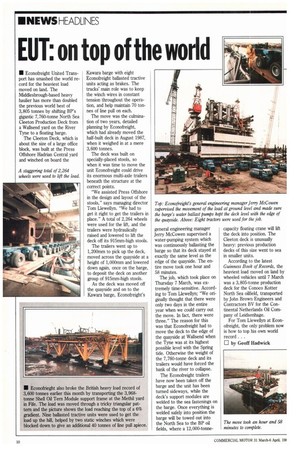EUT: on top of the world
Page 12

If you've noticed an error in this article please click here to report it so we can fix it.
• Econofreight United Transport has smashed the world record for the heaviest load moved on land. The Middlesbrough-based heavy haulier has more than doubled the previous world best of 3,805 tonnes by shifting BP's gigantic 7,760-tonne North Sea Cleeton Production Deck from a Wallsend yard on the River Tyne to a floating barge.
The Cleeton Deck, which is about the size of a large office block, was built at the Press Offshore Hadrian Central yard and winched on board the Kawara barge with eight Econofreight ballasted tractive units acting as brakes. The trucks' main role was to keep the winch wires in constant tension throughout the operation, and help maintain 70 tonnes of line pull on each.
The move was the culmination of two years, detailed planning by Econofreight, which had already moved the half-built deck in August 1987, when it weighed in at a mere 3,600 tonnes.
The deck was built on specially-placed stools, so when it was time to move the unit Econofreight could drive its enormous multi-axle trailers beneath the structure at the correct points.
"We assisted Press Offshore in the design and layout of the stools," says managing director Tom Llewellyn. "We had to get it right to get the trailers in place." A total of 2,264 wheels were used for the lift, and the trailers were hydraulically raised and lowered to lift the deck off its 915mm-high stools.
The trailers went up to 1,200mm to pick up the deck, moved across the quayside at a height of 1,000mm and lowered down again, once on the barge, to deposit the deck on another group of 915mm-high stools.
As the deck was moved off the quayside and on to the Kawara barge, Econofreight's general engineering manager Jerry McCowen supervised a water-pumping system which was continuously ballasting the barge so that its deck stayed at exactly the same level as the edge of the quayside. The entire move took one hour and 58 minutes.
The job, which took place on Thursday 7 March, was extremely time-sensitive. According to Tom Llewellyn; "We originally thought that there were only two days in the entire year when we could carry out the move. In fact, there were three." The reason for this was that Econofreight had to move the deck to the edge of the quayside at Wallsend when the Tyne was at its highest possible level with the Spring tide. Otherwise the weight of the 7,760-tonne deck and its trailers would have forced the bank of the river to collapse.
The Econofreight trailers have now been taken off the barge and the unit has been turned sideways, while the deck's support modules are welded to the sea fastenings on the barge. Once everything is welded safely into position the barge will be towed out into the North Sea to the BP oil fields, where a 12,000-tonne capacity floating crane will lift the deck into position. The Cleeton deck is unusually heavy: previous production decks of this size went to sea in smaller units.
According to the latest Guinness Book of Records, the heaviest load moved on land by wheeled vehicles until 7 March was a 3,805-tonne production deck for the Conoco Kotter North Sea oilfield, transported by John Brown Engineers and Contractors BV for the Continental Netherlands Oil Company of Leidsenhage.
For Tom Llewellyn at Econofreight, the only problem now is how to top his own world record . .
















































































































































